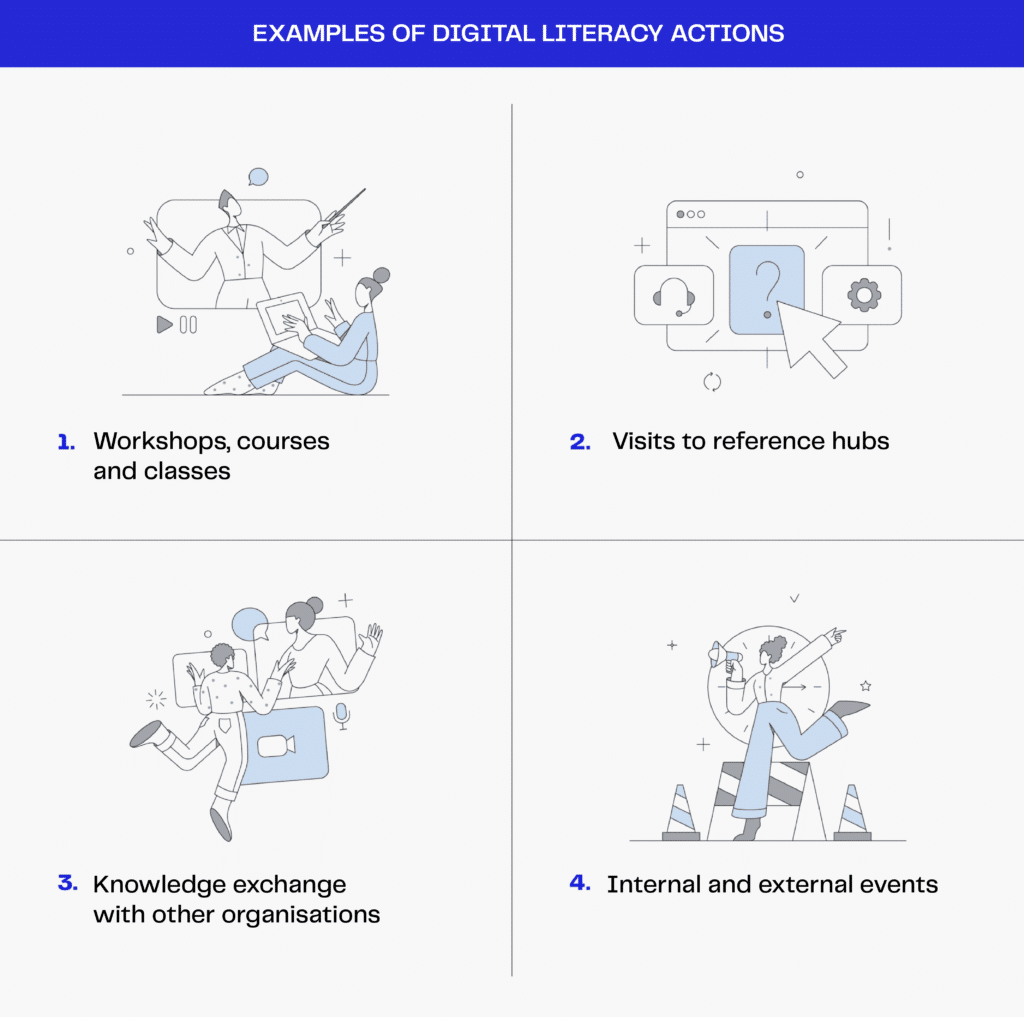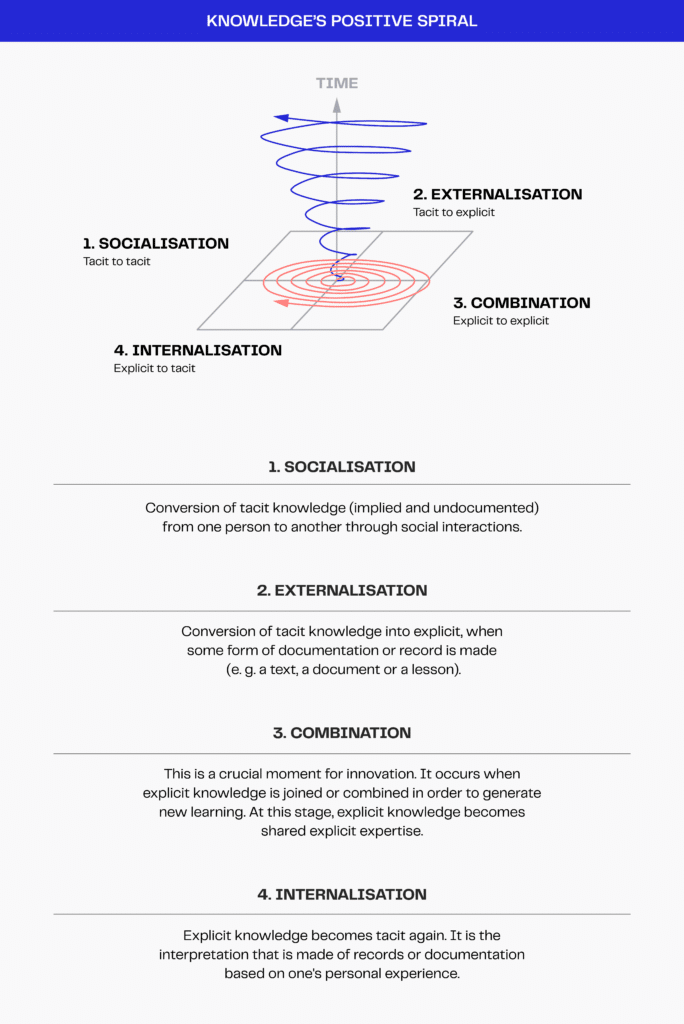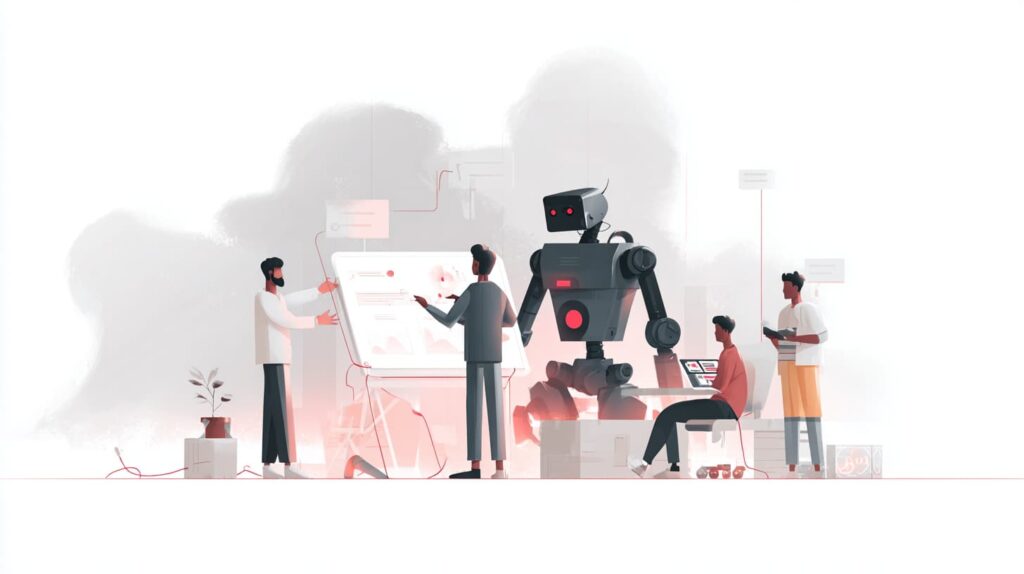By EloInsights, in collaboration with Isabela Correia
Digital literacy is key to unlock people’s and organisations’ ability to use technology as lens to reveal new transformation opportunities.
Digital literacy becomes a lever for implementing a continuous cycle of knowledge internalisation, shaping the organisational culture.
The leadership’s role is to maximise the logic of lifelong learning, cultivating a good grasp of how technologies work and can be applied.
The success of digital transformation is not only linked to the acquisition of technology, but to the way it is used and applied by people in organisations. As George Westerman, a researcher at MIT (Massachusetts Institute of Technology) and a reference in the field of management, points out: “digital transformation needs a heart”. In other words, the optimisation and use of digital assets necessarily involves training people, because they are the ones who really transform the corporate environment.
This is where the importance of digital literacy comes in. It is a process in which the organisation’s employees are exposed, in a structured and permanent way, to learning and knowledge that will enable them to deal with new digital technologies. And, also, use them as lens to visualise application opportunities capable of generating value for the business.
“It is important to understand literacy as a set of actions that promote contact and knowledge between employees and companies and the digital transformation ecosystem”, explains Isabela Correia, senior manager at EloGroup.
Literacy is the combination of a series of strategies. It ranges from the exchange of information on how enabling technologies work to the use of digital methodologies and tools. It can be promoted through workshops, courses, classes, visits to reference hubs, collaborations with other organisations or internal and external events. In this way, it boosts reskilling (when there is a change in the duties of a position) and upskilling (the retraining of employees in the same line of work).
But it does not stop there, as it also helps to fulfil key goals and aims by enabling the maximum exploitation of companies’ technology parks – which often already exist and are up to date from a structural point of view, but are used below their potential.
This is because digital literacy unlocks the organisation’s affordance, since it expands understanding of people’s use of technology and helps reveal new values and applications of digital assets in solving work challenges.

The affordance expansion happens in two dimensions: individual and collective. By developing individually, the collaborators also amplify their ability to use digital tools to see new business opportunities. However, scaling up to the collective level is not linear or automatic and can only be fully achieved when it is incorporated into the organisational culture.
Teams become capable of not only using technology as it was originally intended, but can also mould the use of tools, methods and processes, perfecting techniques and discovering new applications for this asset, considering the needs of the business. This paves the way for taking advantage of so-called embedded opportunities, or opportunities that would remain invisible without the digital lens.
“It is a great transformation lever with two sides. While on one hand digital literacy guarantees the pace and constancy of the exchange of knowledge between teams, on the other it increases the scope that this knowledge can generate as a digital transformation. It promotes the combination of learning between different areas at scale”, states Correia.
Team integration and lifelong learning
Within a digital transformation process, an important part of the challenge lies in giving visibility and scale to solutions that often have already been conceived and implemented. Literacy breaks down barriers so that effective solutions become transversal and are not restricted to the edges of the corporate structure.
In this sense, it helps bringing together leaders, different technical teams and business areas, expanding the understanding of organisational needs and existing opportunities.
Still about the fundamental points that characterise a mature organisational culture that incorporates digital literacy, it is worth highlighting the importance of the lifelong learning logic, in which the development of digital skills is seen as a continuous journey and not a one-off action. This adds malleability to strategies, openness to experimentation, the adoption of agile operating models, as well as other indispensable elements for sustaining the continuous cycles of transformation.
Incorporating digital literacy as one of the mechanisms embedded in an organisational culture based on continuous learning is one of the factors that gives origin to a positive knowledge spiral. This movement leverages use cases and the integration of various digital transformation enabling technologies – such as advanced analytics, cloud computing, artificial intelligence and automation. Here is a closer look at how it is formed.
The positive spiral in digital transformation
The concept of the positive spiral comes from the field of education and refers to the stages through which knowledge ceases to be mere information and becomes internalised and aggregated as a formative part of a culture. These four phases are:

In the first two stages, knowledge starts from a subtextual nature, when one person teaches another informally, until it is externalised and formalised in some kind of record, such as a lesson on a particular topic. The third stage is key, as the knowledge of several people comes together. Knowledge is combined to form new learning, and individual explicit knowledge becomes shared explicit knowledge. Finally, in the fourth stage, learning is internalised, based on everyone’s ability and interpretation.
An important part of the value of digital literacy is generated as initiatives are created to exchange the knowledge acquired along the transformational journey.
It is in the orbit of this positive spiral that affordance can translate into paths and opportunities for innovation. Digital literacy becomes a great lever for putting learning into a cycle of internalisation, expanding the potential for using technology in transformations. Knowledge related to digital assets begins to circulate and be mastered by larger groups of people, until the point in which it ceases to be new.
The role of leadership in promoting digital literacy
It is in the multiplicity of exchanges and the richness of experiences, especially those involving practical application, that digital affordance is unlocked and lenses are obtained to see new perspectives based on what the market already practices, bringing a gain in digital maturity to the organisation.
For leaders, one example of what they can gain from engaging in learning processes that enrich their digital intelligence is an increased ability to evaluate digital technologies and solutions that respond to business needs. This doesn’t mean that these leaders need to become specialists or develop hard skills such as programming or data science.
The book The Technology Fallacy, written by experts in partnership with MIT, listened to more than 3,000 respondents to conclude that digital leadership is about being able to consciously (and well-informedly) navigate a new business environment marked by constant technological disruption. In other words, digital literacy needs to be present at C-level in order to make the connection with the top of organisations.
Those who lead must understand the general principles of how technology works. Having a good understanding of when, why and how to use it is increasingly crucial, firstly to be guided by changes and have a transformative vision, accompanying and naming new flows of value generation for the organisation; secondly, because it increases the quality of decision-making in times of uncertainty. It also improves the employee experience and the effectiveness of digital assets, especially when many work from home.
Recognising and checking in the current degree of digital integration in the business makes it possible to judge whether an emerging technology is really appropriate, for example.
Evaluating the level of literacy and return for the business
Consolidating a learning culture is a long internal process that requires resilience and a focus on the employee. Leadership must engage, sponsor and make the team available for actions within the digital literacy strategies, bearing in mind that they need to be carried out during working hours.
Without encouragement, knowledge cannot be absorbed even if an incredible programme is designed. Influencing changes in behaviour and the adoption of new procedures has not only a cognitive dimension, but also a social one. People learn better by practising and exchanging with other peers.
This brings us to the decisive point of the discussion: how can we assess the level of literacy and the return that digital literacy brings to the business?
It is possible to measure the volume of initiatives and opportunities created from a range of digital practices and processes that are or become relevant to an organisation’s daily operations.
Learning can and should be assessed through questionnaires and tests related to the level of mastery of employees before and after literacy actions. In practice, these are questions about the concepts and applications of digital skills in the work context, often with real examples and debates about the digital solution that can be adopted to solve a particular business problem. Measurement before and after the activities also helps to monitor the evolution of technical mastery.
From an organisational perspective, digital maturity can be measured through the central outcome of digital literacy: a transformation portfolio. This set projects will be aligned with the organisation’s transformation strategy through the exchange of knowledge promoted, diversifying the technologies used and helping the convergence of actions between different areas.
The greater the volume and degree of integration, the more refined the lenses of the teams involved will be. Within this portfolio, it is also possible to measure the gains obtained directly from the initiatives raised in the digital literacy actions, estimating the impact of the training.
“There is a scale of gain for the organisation with these newly identified opportunities, which cannot always be quantified at once. However, over the course of the transformation journey, it is a mechanism that will certainly boost the results of the digital transformation, including the financial ones”, guarantees Correia.
To paraphrase the final extract from the book Technology Fallacy: Getting started is often the hardest part. The key is to break down the barriers to digital maturity. Promoting digital literacy can boost less mature areas of the organisation that are just on hold, waiting to move.
ISABELA CORREIA works as Senior Manager at EloGroup











